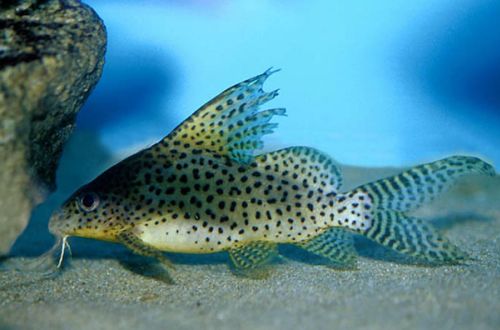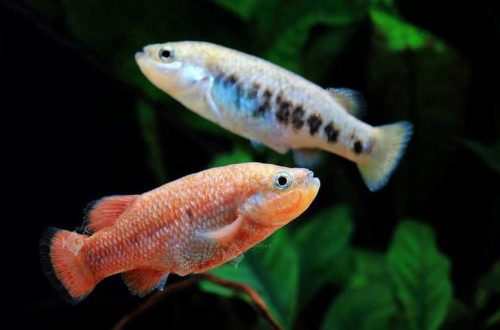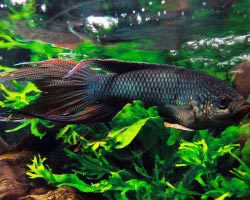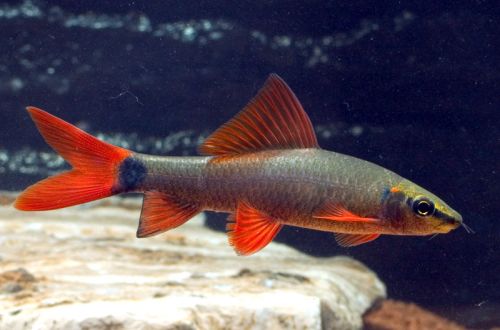
Synodontis veil
Synodontis veil or Synodontis eupterus (Synodontis eupterus) belongs to a group of catfish that often swim upside down. However, this catfish does not do this all the time, so you should not worry when you see such unusual behavior. A characteristic feature of Synodontis is also the ability to make a creaking sound that warns predators or partners during spawning.

The catfish is able to decorate any aquarium with itself; when kept alone, it becomes especially beautiful. Once having chosen a shelter for himself, he begins to consider it a home and protect it from strangers. Compatible with other of its relatives, but provided that the aquarium is large and it has enough spacious unoccupied shelters.
Synodontis can be aggressive towards other bottom fish species living in similar conditions, so species living in the water column or near the surface may be the best choice. This type of catfish is one of the few that can live together with African cichlids – predatory, territorial fish.
Habitat
Synodontis veil (Synodontis eupterus) received a scientific description in 1901. Fish inhabit the reservoirs of a significant part of Central Africa – Nigeria, Chad, Sudan, Ghana, Mali, Niger and Cameroon, and are also found in the famous White Nile river system.
In the wild, it lives in muddy rivers with a silty or rocky bottom with a fast current. The fish is omnivorous, consumes everything that is edible, including algae, prefers insect larvae. Often they live alone, however, they can stray into groups, the composition of which is very unstable.
Description
Synodontis veil is quite large, an adult reaches 30 cm, but rarely exceeds 20 cm in aquariums. Under favorable conditions, catfish can live for about 10 years, and in some nurseries cases have been recorded when some individuals have lived for more than 25 years.
The shape of the body is flattened from the sides of a triangular shape, the highest point is a high dorsal fin. Long flexible antennae allow you to search for food by going through the bottom and feeling objects. The color of the body can vary from light gray to dark, almost black with distinct dots – “polka dots”. The catfish stands out for its large fins. Juveniles are similar to adults but lack the distinctive wide dorsal fin.
Food
The catfish has a wide diet – it eats almost any food from algae to insects, so if Synodontis is kept in an aquarium together with other fish, then there is no need to choose food specifically for it. Also, unlike its other relatives, the feeder does not have to be placed above the shelter where the fish lives, if necessary, she herself finds food even in the daytime. Types of feed used: vegetable industrial feed, dry flakes, granules, tablets, meat products, including frozen, live food, such as small earthworms once a week.
Maintenance and care
The fish is not demanding on the conditions of keeping, withstands significant fluctuations in water parameters. Since the water in the aquarium is not flowing, there is a threat of accumulation of waste products in the bottom layer and the appearance of free ammonia, therefore it is recommended to periodically – once every two weeks – clean the gravel with a siphon and renew the water 10 – 15% of the total volume.
For successful maintenance, a spacious aquarium of at least 180 liters is required, with a lot of shelters, in particular snags. Catfish like to chase each other through the underwater passages, while feeling safe. Having chosen the shelter, he spends most of his life in it. In the design, preference should be given to porous rocks such as tuff, often used for aquariums with cichlids. Coarse sand and smooth gravel should be used as a substrate to reduce the chance of damage to sensitive whiskers. Floating plants can create shaded areas, and it is worth planting in the substrate only with a strong root system, all other plants can be easily pulled out by the catfish.
Social behavior
Synodontis veil is not aggressive, but it cannot be called peaceful either, it poses a threat to small fish, so individuals of a similar size should be preferred as neighbors. Trouble can also be delivered to sluggish fish, Synodontis is able to quickly eat a large amount of food at a time, thereby leaving other inhabitants of the aquarium hungry.
This species has a complex hierarchy system, directly related to the size of the fish – the largest individual gets the best shelter, driving others to the periphery. In addition, this is one of the few species that is a great addition to African cichlids.
Breeding / breeding
Sexual differences are practically not observed and are reduced solely to size – the female is larger than the male. In home aquariums, catfish do not breed; offspring are obtained in fish farms with the addition of hormones.
Diseases
The fish is very hardy, no cases of the disease have been recorded in aquariums in which the necessary living conditions are recreated. However, the possibility of an epidemic cannot be ruled out; more information about diseases can be found in the section “Diseases in aquarium fish”.





